Mary Nanna, excellent seamstress of Make it Smirk fame, commented "You mention using elastic in the seams with the merino - can you explain this process?"
Despite a sneaking suspicion that Mary Nanna is much better at sewing than I, and could possibly be asking this question with the aim of provoking some smirking from champion sewers of knits, here is my approach to this process, developed by close inspection and some destruction of RTW, and considerable trial and error. Please note that I am a self taught seamstress and profess no qualifications in the "right" way to carry out any sewing what so ever. (That disclaimer was for Bunny, because she has a very good point about tutorials). This is how I use elastic in the seams of knits. Your results may not be the same ;)
1. Inspect the fabric. Deliciously buttery stretchy fabric that ripples into a puddle on the sewing room floor at every opportunity is a very good candidate for elastic in the seams. If your knit is stable and has fabulous recovery, elastic may not be of much use to you, and may just increase bulk in your seams.
2. Consider your seams. Elastic is useful in knits for seams that you want to stretch just a bit, but not too much. Seams under stress, that you do not want to stretch at all (eg fitted shoulder seams) may require more stability than elastic can offer. For example: I regularly use twill tape or woven fabric selvage in shoulder seams on knits - voile or organza in a fine knit, and quilting/shirting cotton for a medium knit. Other people regularly use clear elastic in shoulder seams with good results, but this has not been my experience.
3. Elastic, Foot, Needle and stitch selection:
These decisions depend on several factors. For merino knits, swim wear, and thin rayon knits, I use a clear elastic described as "swimwear" elastic, produced by Beutron, and supplied in Australia by J.D.Leutenegger. I buy it by the roll, and use a roll within 2 years or so, so the elastic is relatively fresh. I find that this elastic is difficult to sew with a ball point needle, which is recommend for knitted fabric, and which is the needle I tend to use for merino where elastic is not involved. Instead I use a stretch needle of 70 or above when using elastic in the seams. As I am lazy, I generally do not change the needle back to a ball point to complete the remainder of the garment, which has occasionally lead to stitch problems with fine fabrics. I generally use a walking foot on my conventional machine when sewing with knits, and have much better success when sewing elastic if I am using the walking foot rather than when using a regular foot.
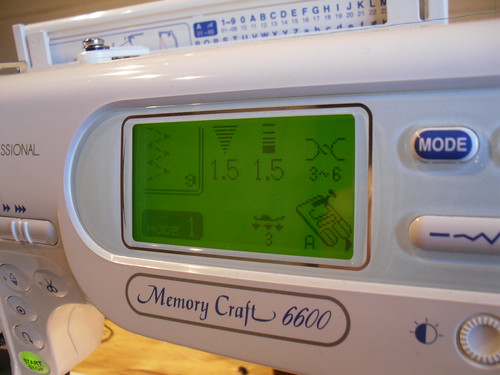
The stitch I like to use when including elastic in the seam is a 3 step zigzag, with stitch length of between 1.0 and 2.0mm and stitch width of between 1.0 and 1.5mm. On occasion, when I am using the elastic to assist in gathering the fabric, I use a straight stitch.
4. Consider the purpose of the elastic
a) Supporting a stretch seam
In the raglan merino top I made recently (Vogue 8364) leading to Mary Nanna's question, I wanted the elastic to support the seams mostly vertically, as the fabric was very unstable, and did not have a snappy recovery. (Merino rib knit). I suspected that should I sew this garment without using elastic, my top would end up knee length by the end of the day, with sleeves extending well past my finger tips.
I sewed the elastic on top of the seam without stretching, just holding it in place as I sewed the regular seam.

I did this for all of the raglan seams, the neckline seam and for the sleeve and side seams, so that the top does not stretch out of shape during wear, nor during washing. I clip the elastic where seams intersect.

Adding the elastic to the seams worked very nicely, even though I hung the top on the line to dry (folded in the middle over the line) instead of laying it flat on a towel to dry as would have been the most garment protective option ;).
In the following top, Vogue 8305, which I sewed for my demonstration photos, I used the elastic differently. This merino jersey top has some lycra in it, and has better recovery than the merino rib fabric used in Vogue 8. The elastic requirements are different.
b) Preventing gaping in a neck seam
I used elastic in the neckline-facing seam. I had previously found that this wrap over style tended to gape during wear, so I stretched the elastic slightly as I sewed it directly over the seam, gathering the seam very slightly. To do this, I used the same needle, foot and stitch length, but stretched the elastic equally to the front and the back at the same time (so that the needle was not pulled to either direction. I stretch the front with my right hand and the back with my left hand.

(just pretend that photo has the elastic being pulled straight from the front - pressing the button on the camera was tricky with my left hand)

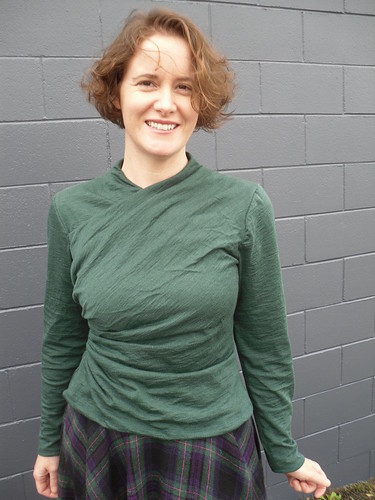
In wear, the intention is that the the slight gathering will be stretched out by the body, so that the neckline lays flat. This is where trail and error come in!
For this garment I did not use any elastic in the sleeve or side seams with the following exception-
c) A stretchable stay for gathering or pleats
The other use of elastic in this garment was as a stay for the gathering at the side seam. This gathered area needs to stretch with the garment, but when unsupported, has a tendency to droop in a southerly direction, ruining the line of the dress and giving an unfortunate impression of pot bellied-ness. In this seam, the gathered fabric is overlaid with the unstretched elastic, and the same 3 step zig zag is used to attach the elastic as a stay before the side seam is sewn.
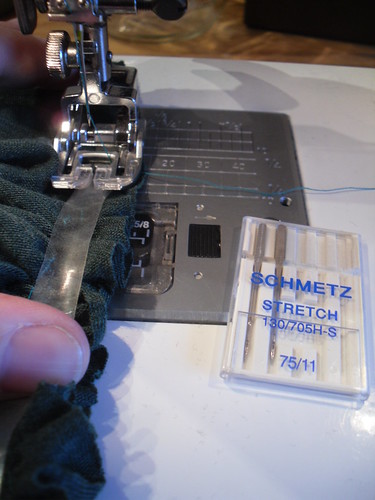
Here I guide the fabric front and back using my left hand to hold the elastic in place, without stretching.
d) To increase the recovery of a knit fabric within a binding
In Jalie 2795, the sweetheart top, which I have made many times, the front bodice binding is stretched significantly to shape the t shirt.
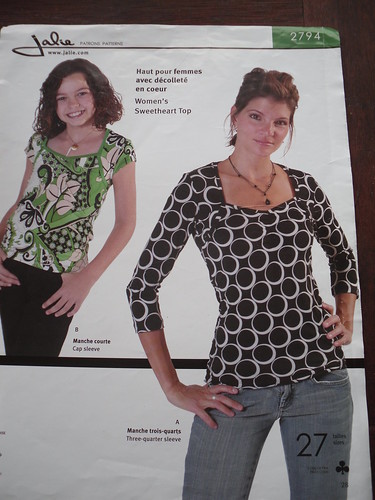
My merino knit did not have enough recovery, in my opinion, to shape the neckline sufficiently without unsightly rippling and bagging of the finished front neckline.
In this instance, I placed the unstretched clear elastic inside the folded binding and overlocked the three layers together.
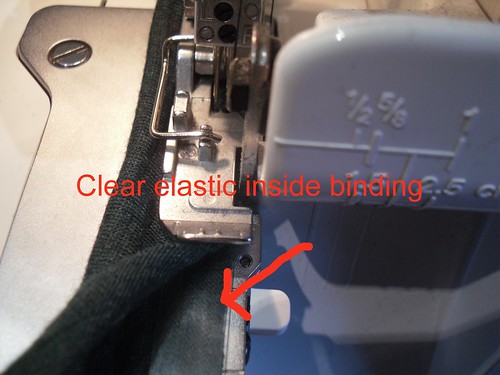
When I later stretched this binding to fit the front bodice piece per the instructions, the elastic ensured that the bodice was gathered in as if I had used a fabric with better elasticity than my merino jersey. (The seam is also topstitched through the elastic)
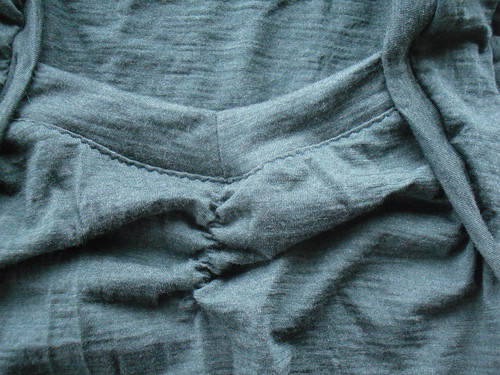
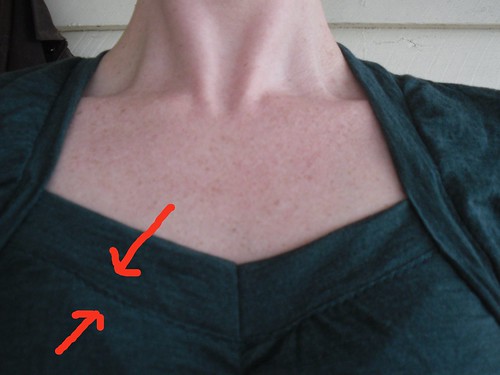
Elastic in seams gives the garment more longevity, sometimes more stability and sometimes more recovery. Using it is a bit of a trial and error process, but for me, it was worth some experimental sewing.
11 comments:
Why thank you for this detailed answer - very useful. I still have much to learn about knits. I haven't had a great deal of success with merino - because of its poor recovery and bulkiness - many things have not been the successes I had imagined - and as you know, merino is hardly a cheap experiment.
I notice that in the last couple of years, the types of merino coming in to Global fabrics (the Fabric store) have changed. There seem to be more 'mixed fibre ' to conter-act some of the problems of pure merino or they are being milled with more stability. At any rate, I am hopeful for more success in the future as it is a lovely fabric to wear!
I laughed about Bunny's rant on Internet tutorials. I've probably given my share of crap advice in the past - in the spirit of "you don't know what you don't know" - technically called "unconscious incompetence" by educationalists - but meaning well nonetheless.
However, if you believe everything you read on the Internet you're an idiot so I put it more down to "reader beware" - and let me say for the record, no where is this more essential than cooking blogs.
Most people have the discernment to see whether a sewing tutorial is going to help them or not - but a bad recipe, you don't know until you've wasted your great ingredients on it.
i cannot even begin to tell you how many things I've binned from Internet recipes which is when I developed a loving relationship with the Book depository and now I pay proper money for great cookbooks - maybe there is an analogy here with sewing blogs - there is some great stuff out there on the net - but if you want a professional service, then it will cost money.
Funny how you wrote this blog post today. I just chucked away the top I'd been wearing today after only its third wear. It was a gorgeous butter soft rayon knit that I paid a good price for. Had I thought to use this technique, it would still be wearable, instead of being relegated to the pile of soft fabrics I use for rubbing sno-seal into my leather goods. Thank you! I will be using your method very soon.
I have never had any success with clear elastic...after reading this, I am wondering if perhaps I needed a different needle? Thanks for your info.
I'm off to read the gripe about tutorials next...
I haven't sewn a lot with merino fabrics so really value your insights and tips! Thanks!
You make it look so easy. I haven't used clear elastic in years since it used to give me so much trouble. However, I can see the benefits of using it with fabrics like Merino knits.
I confess I enjoyed the link to Bunny's blog. Glad I am not the only one who thinks these kind of things.
Mary Nanna - I am sure it must be similar for all types of hobbies and interests. Photography springs to mind.
I really struggled with the Jalie Sweetheart top (which was one of my early attempts at sewing with knits), and the experience sort of soured me with the use of clear elastic.
I'll definitely bookmark your post and refer to it when I use clear elastic again - very helpful, thank you! :)
Thank you very much for this detailed explanation of the various ways to use clear elastic, and other materials. I have had pretty good luck with knits so far...the operative word is luck--->I have not ever deliberated about whether or not to use elastic. Now I will.
Thanks for your ideas. I have a habit of loving rib knits for tops and struggle to manage my stretch and recovery of rib knits vs the fabric's stretch and nil recovery reality.
I'll be using your method for managing the Jalie sweetheart neckline better. And also for a similar Vogue kniti top that really had me stumped.
Really informative,thank you ... I shall have to remember to come back when I'm struggling with a less than straight forward knit pattern.
Karen thank you for this very detailed description of using elastic. I have just made my first knit top (yet to be blogged about) and I found this extremely useful. I (of course) could not find my elastic but went ahead as I was just testing the pattern for fit and I don't think it needs it but I do have a beautiful soft fabric that will need it. I aim to be able to sew those beautiful merino knit fabrics. I have some I bought and gee they are fantastic. I did go and buy some more yesterday!
Great info! I never thought to use elastic in the seams of wimpy fabric, but it makes so much sense.
Post a Comment